Preparation, Physicochemical, and Cyto- and Genotoxic Characterisation of Polysaccharide Composites Containing Carbon Quantum Dots
Abstract
:1. Introduction
2. Materials and Methods
2.1. Materials
2.1.1. Synthesis of Carbon Quantum Dots
2.1.2. Synthesis of Nanocomposites
2.1.3. Cytotoxicity Tests
2.2. Methods
2.2.1. Synthesis of Carbon Quantum Dots
2.2.2. Preparation of the Polymer Matrix
2.2.3. Obtaining Nanocomposites
2.2.4. Electron Microscope Analysis (SEM/TEM)
2.2.5. Fourier Transform Infrared Attenuated Total Reflection (FTIR-ATR) Spectroscopy
2.2.6. Ultraviolet–Visible (UV-Vis) Absorption Spectroscopy
2.2.7. Colour Measurement
2.2.8. Opacity
2.2.9. Determination of Water Content, Solubility, and Degree of Swelling
2.2.10. Mechanical Tests
2.2.11. Thickness Measurement
2.2.12. Contact Angle and Surface Free Energy Measurements
2.2.13. Photoluminescence Spectroscopy
2.2.14. Changes Observed in the Fluorescence Emission of the Sample under the Influence of Heavy Metals and Amino Acids
2.2.15. Exposure of Mouse Whole Blood to Films Containing Carbon Dots
2.2.16. Cell Viability Assessment
2.2.17. Comet Test
2.2.18. Statistical Analysis
3. Results and Discussion
3.1. Electron Microscope Analysis
3.2. FTIR-ATR Spectroscopy
3.3. UV-Vis Spectroscopy
3.4. Measurements of Colour and Degree of Opacity
3.5. Water Content, Solubility, and Swelling Degree of the Film
3.6. Measurements of Contact Angle and Surface Free Energy
3.7. Photoluminescence Spectroscopy and Changes in the Sample under the Influence of Heavy Metals and Amino Acids
3.8. Cell Viability Assessment
3.9. Comet Test
4. Conclusions
Author Contributions
Funding
Institutional Review Board Statement
Informed Consent Statement
Data Availability Statement
Conflicts of Interest
References
- Ureña, M.; Phùng, T.T.T.; Gerometta, M.; de Siqueira Oliveira, L.; Chanut, J.; Domenek, S.; Dole, P.; Roudaut, G.; Lagorce, A.; Karbowiak, T. Potential of Polysaccharides for Food Packaging Applications. Part 1/2: An Experimental Review of the Functional Properties of Polysaccharide Coatings. Food Hydrocoll. 2023, 144, 108955. [Google Scholar] [CrossRef]
- Ureña, M.; Fournier, P.; Phùng, T.T.T.; Lagorce, A.; Karbowiak, T. Potential of Polysaccharides for Food Packaging Applications. Part 2/2: An Experimental Review of the Effect of Aging Conditions on the Functional Properties of Polysaccharide Films. Food Hydrocoll. 2023, 144, 108954. [Google Scholar] [CrossRef]
- Cui, C.; Ji, N.; Wang, Y.; Xiong, L.; Sun, Q. Bioactive and Intelligent Starch-Based Films: A Review. Trends Food Sci. Technol. 2021, 116, 854–869. [Google Scholar] [CrossRef]
- Primožič, M.; Knez, Ž.; Leitgeb, M. (Bio)Nanotechnology in Food Science—Food Packaging. Nanomaterials 2021, 11, 292. [Google Scholar] [CrossRef] [PubMed]
- Krystyjan, M.; Khachatryan, G.; Khachatryan, K.; Konieczna-Molenda, A.; Grzesiakowska, A.; Kuchta-Gładysz, M.; Kawecka, A.; Grzebieniarz, W.; Nowak, N. The Functional and Application Possibilities of Starch/Chitosan Polymer Composites Modified by Graphene Oxide. Int. J. Mol. Sci. 2022, 23, 5956. [Google Scholar] [CrossRef] [PubMed]
- Naskar, A.; Sanyal, I.; Nahar, N.; Ghosh, D.D.; Chakraborty, S. Bionanocomposites Films Applied as Active and Smart Food Packaging: A Review. Polym. Eng. Sci. 2023, 63, 2675–2699. [Google Scholar] [CrossRef]
- Wang, L.; Liu, X.; Qi, P.; Sun, J.; Jiang, S.; Li, H.; Gu, X.; Zhang, S. Enhancing the Thermostability, UV Shielding and Antimicrobial Activity of Transparent Chitosan Film by Carbon Quantum Dots Containing N/P. Carbohydr. Polym. 2022, 278, 118957. [Google Scholar] [CrossRef]
- Ezati, P.; Rhim, J.W. Pectin/Carbon Quantum Dots Fluorescent Film with Ultraviolet Blocking Property through Light Conversion. Colloids Surf. B Biointerfaces 2022, 219, 112804. [Google Scholar] [CrossRef]
- Das, T.K.; Ganguly, S. Revolutionizing Food Safety with Quantum Dot–Polymer Nanocomposites: From Monitoring to Sensing Applications. Foods 2023, 12, 2195. [Google Scholar] [CrossRef]
- Wei, X.; Yang, J.; Hu, L.; Cao, Y.; Lai, J.; Cao, F.; Gu, J.; Cao, X. Recent Advances in Room Temperature Phosphorescent Carbon Dots: Preparation, Mechanism, and Applications. J. Mater. Chem. C 2021, 9, 4425–4443. [Google Scholar] [CrossRef]
- Mansuriya, B.D.; Altintas, Z. Carbon Dots: Classification, Properties, Synthesis, Characterization, and Applications in Health Care—An Updated Review (2018–2021). Nanomaterials 2021, 11, 2525. [Google Scholar] [CrossRef] [PubMed]
- Kalpana, R.; Sakthi Vignesh, N.; Vinothini, K.; Rajan, M.; Ashokkumar, B.; Brindhadevi, K.; Thuy Lan Chi, N.; Pugazhendhi, A.; Varalakshmi, P. Carbon Quantum Dots (CQD) Fabricated from Exiguobacterium Sp. VK2 Exopolysaccharide (EPS) Using Hydrothermal Reaction and Its Biodiesel Applications. Fuel 2023, 333, 126426. [Google Scholar] [CrossRef]
- Deepika; Kumar, L.; Gaikwad, K.K. Carbon Dots for Food Packaging Applications. Sustain. Food Technol. 2023, 1, 185–199. [Google Scholar] [CrossRef]
- Aswathi, V.P.; Meera, S.; Maria, C.G.A.; Nidhin, M. Green Synthesis of Nanoparticles from Biodegradable Waste Extracts and Their Applications: A Critical Review. Nanotechnol. Environ. Eng. 2022, 8, 377–397. [Google Scholar] [CrossRef]
- Szczepankowska, J.; Khachatryan, G.; Khachatryan, K.; Krystyjan, M. Carbon Dots—Types, Obtaining and Application in Biotechnology and Food Technology. Int. J. Mol. Sci. 2023, 24, 14984. [Google Scholar] [CrossRef] [PubMed]
- Krystyjan, M.; Khachatryan, G.; Khachatryan, K.; Krzan, M.; Ciesielski, W.; Żarska, S.; Szczepankowska, J. Polysaccharides Composite Materials as Carbon Nanoparticles Carrier. Polymers 2022, 14, 948. [Google Scholar] [CrossRef] [PubMed]
- Ezati, P.; Priyadarshi, R.; Rhim, J.W. Prospects of Sustainable and Renewable Source-Based Carbon Quantum Dots for Food Packaging Applications. Sustain. Mater. Technol. 2022, 33, e00494. [Google Scholar] [CrossRef]
- Shi, W.; Han, Q.; Wu, J.; Ji, C.; Zhou, Y.; Li, S.; Gao, L.; Leblanc, R.M.; Peng, Z. Synthesis Mechanisms, Structural Models, and Photothermal Therapy Applications of Top-Down Carbon Dots from Carbon Powder, Graphite, Graphene, and Carbon Nanotubes. Int. J. Mol. Sci. 2022, 23, 1456. [Google Scholar] [PubMed]
- Kang, H.; Kim, D.Y.; Cho, J. Top-Down Fabrication of Luminescent Graphene Quantum Dots Using Self-Assembled Au Nanoparticles. ACS Omega 2023, 8, 5885–5892. [Google Scholar] [CrossRef]
- Pourmadadi, M.; Rahmani, E.; Rajabzadeh-Khosroshahi, M.; Samadi, A.; Behzadmehr, R.; Rahdar, A.; Ferreira, L.F.R. Properties and Application of Carbon Quantum Dots (CQDs) in Biosensors for Disease Detection: A Comprehensive Review. J. Drug Deliv. Sci. Technol. 2023, 80, 104156. [Google Scholar] [CrossRef]
- El-borlsy, H.; Hanafy, N.A.N.; El-Kemary, M.A. Development and Application of Naturally Derived, Cost-Effective CQDs with Cancer Targeting Potential. Cell Biol. Int. 2023, 47, 808–822. [Google Scholar] [CrossRef] [PubMed]
- Babu, A.K.; Raja, M.K.M.M.; Zehravi, M.; Mohammad, B.D.; Anees, M.I.; Prasad, C.; Yahya, B.A.; Sultana, R.; Sharma, R.; Singh, J.; et al. An Overview of Polymer Surface Coated Synthetic Quantum Dots as Therapeutics and Sensors Applications. Prog. Biophys. Mol. Biol. 2023, 184, 1–12. [Google Scholar] [CrossRef] [PubMed]
- Krystyjan, M.; Khachatryan, G.; Grabacka, M.; Krzan, M.; Witczak, M.; Grzyb, J.; Woszczak, L. Physicochemical, Bacteriostatic, and Biological Properties of Starch/Chitosan Polymer Composites Modified by Graphene Oxide, Designed as New Bionanomaterials. Polymers 2021, 13, 2327. [Google Scholar] [CrossRef] [PubMed]
- Stanisławska, N.; Khachatryan, G.; Khachatryan, K.; Krystyjan, M.; Makarewicz, M.; Krzan, M. Formation and Investigation of Physicochemical and Microbiological Properties of Biocomposite Films Containing Turmeric Extract Nano/Microcapsules. Polymers 2023, 15, 919. [Google Scholar] [CrossRef] [PubMed]
- ISO 527-1:2019; Plastics—Determination of Tensile Properties—Part 1: General Principles. ISO: Geneva, Switzerland, 2019. Available online: https://www.iso.org/standard/75824.html (accessed on 21 January 2023).
- Krystyjan, M.; Khachatryan, G.; Ciesielski, W.; Buksa, K.; Sikora, M. Preparation and Characteristics of Mechanical and Functional Properties of Starch/Plantago Psyllium Seeds Mucilage Films. Starch/Staerke 2017, 69, 1700014. [Google Scholar] [CrossRef]
- Hovhannisyan, A.; Janik, M.; Woszczak, L.; Khachatryan, G.; Krystyjan, M.; Lenart-Boroń, A.; Stankiewicz, K.; Czernecka, N.; Duraczyńska, D.; Oszczęda, Z.; et al. The Preparation of Silver and Gold Nanoparticles in Hyaluronic Acid and the Influence of Low-Pressure Plasma Treatment on Their Physicochemical and Microbiological Properties. Int. J. Mol. Sci. 2023, 24, 17285. [Google Scholar] [CrossRef] [PubMed]
- Rudawska, A.; Jacniacka, E. Analysis for Determining Surface Free Energy Uncertainty by the Owen-Wendt Method. Int. J. Adhes. Adhes. 2009, 29, 451–457. [Google Scholar] [CrossRef]
- Singh, N.P.; McCoy, M.T.; Tice, R.R.; Schneider, E.L. A Simple Technique for Quantitation of Low Levels of DNA Damage in Individual Cells. Exp. Cell Res. 1988, 175, 184–191. [Google Scholar] [CrossRef] [PubMed]
- Grzebieniarz, W.; Nowak, N.; Khachatryan, G.; Krzan, M.; Krystyjan, M.; Kosiński, J.; Khachatryan, K. The Preparation and Characterization of Quantum Dots in Polysaccharide Carriers (Starch/Chitosan) as Elements of Smart Packaging and Their Impact on the Growth of Microorganisms in Food. Materials 2021, 14, 7732. [Google Scholar] [CrossRef]
- Radzimierska-Kazmierczak, M.; Smigielski, K.; Sikora, M.; Nowak, A.; Plucinska, A.; Kunicka-Styczynska, A.; Czarnecka-Chrebelska, K.H. Olive Oil with Ozone-Modified Properties and Its Application. Molecules 2021, 26, 3074. [Google Scholar] [CrossRef]
- Huang, C.C. Microstructure and Thermal Property of Designed Alginate-Based Polymeric Composite Foam Materials Containing Biomimetic Decellularized Elastic Cartilage Microscaffolds. Materials 2021, 15, 258. [Google Scholar] [CrossRef] [PubMed]
- Khachatryan, G.; Khachatryan, K.; Szczepankowska, J.; Krzan, M.; Krystyjan, M. Design of Carbon Nanocomposites Based on Sodium Alginate/Chitosan Reinforced with Graphene Oxide and Carbon Nanotubes. Polymers 2023, 15, 925. [Google Scholar] [CrossRef] [PubMed]
- Chen, P.; Xie, F.; Tang, F.; McNally, T. Graphene Oxide Enhanced Ionic Liquid Plasticisation of Chitosan/Alginate Bionanocomposites. Carbohydr. Polym. 2021, 253, 117231. [Google Scholar] [CrossRef] [PubMed]
- Nowak, N.; Grzebieniarz, W.; Khachatryan, G.; Khachatryan, K.; Konieczna-Molenda, A.; Krzan, M.; Grzyb, J. Synthesis of Silver and Gold Nanoparticles in Sodium Alginate Matrix Enriched with Graphene Oxide and Investigation of Properties of the Obtained Thin Films. Appl. Sci. 2021, 11, 3857. [Google Scholar] [CrossRef]
- Tüzemen, E.Ş.; Eker, S.; Kavak, H.; Esen, R. Dependence of Film Thickness on the Structural and Optical Properties of ZnO Thin Films. Appl. Surf. Sci. 2009, 255, 6195–6200. [Google Scholar] [CrossRef]
- Benramache, S.; Temam, H.B.; Arif, A.; Guettaf, A.; Belahssen, O. Correlation between the Structural and Optical Properties of Co Doped ZnO Thin Films Prepared at Different Film Thickness. Optik 2014, 125, 1816–1820. [Google Scholar] [CrossRef]
- Zaki, S.A.; Abd-Elrahman, M.I.; Abu-Sehly, A.A. Optical and Electrical Properties of Amorphous Sb2S3 Thin Films: Effect of the Film Thickness. J. Non-Cryst. Solids 2021, 552, 120318. [Google Scholar] [CrossRef]
- Lou, Y.; Hao, X.; Liao, L.; Zhang, K.; Chen, S.; Li, Z.; Ou, J.; Qin, A.; Li, Z. Recent Advances of Biomass Carbon Dots on Syntheses, Characterization, Luminescence Mechanism, and Sensing Applications. Nano Sel. 2021, 2, 1117–1145. [Google Scholar] [CrossRef]
- Ge, M.; Huang, X.; Ni, J.; Han, Y.; Zhang, C.; Li, S.; Cao, J.; Li, J.; Chen, Z.; Han, S. One-Step Synthesis of Self-Quenching-Resistant Biomass-Based Solid-State Fluorescent Carbon Dots with High Yield for White Lighting Emitting Diodes. Dye. Pigment. 2021, 185, 108953. [Google Scholar] [CrossRef]
- Wang, L.; Wang, X.; Zhou, S.; Ren, J.; Liu, L.; Xiao, C.; Deng, C. Single-Particle Dispersion of Carbon Dots in the Nano-Hydroxyapatite Lattice Achieving Solid-State Green Fluorescence. Nanoscale Adv. 2023, 5, 3304–3315. [Google Scholar] [CrossRef]
- Neupane, L.N.; Park, J.Y.; Park, J.H.; Lee, K.H. Turn-on Fluorescent Chemosensor Based on an Amino Acid for Pb(II) and Hg(II) Ions in Aqueous Solutions and Role of Tryptophan for Sensing. Org. Lett. 2013, 15, 254–257. [Google Scholar] [CrossRef] [PubMed]
- Shen, Y.; Rong, M.; Qu, X.; Zhao, B.; Zou, J.; Liu, Z.; Bao, Y.; He, Y.; Li, S.; Wang, X.; et al. Graphene Oxide-Assisted Synthesis of N, S Co-Doped Carbon Quantum Dots for Fluorescence Detection of Multiple Heavy Metal Ions. Talanta 2022, 241, 123224. [Google Scholar] [CrossRef] [PubMed]
- Batool, M.; Junaid, H.M.; Tabassum, S.; Kanwal, F.; Abid, K.; Fatima, Z.; Shah, A.T. Metal Ion Detection by Carbon Dots—A Review. Crit. Rev. Anal. Chem. 2022, 52, 756–767. [Google Scholar] [CrossRef] [PubMed]
- Wang, R.; He, S.; Liu, W.; Pei, H.; Liu, N.; Guo, R.; Mo, Z. Long Wavelength Emission Multicolor Fluorescent Carbon Quantum Dots for the Detection of PH, Amino Acids, and Metal Ions. J. Photochem. Photobiol. A Chem. 2023, 444, 114967. [Google Scholar] [CrossRef]
- Chauhan, P.; Mundekkad, D.; Mukherjee, A.; Chaudhary, S.; Umar, A.; Baskoutas, S. Coconut Carbon Dots: Progressive Large-Scale Synthesis, Detailed Biological Activities and Smart Sensing Aptitudes towards Tyrosine. Nanomaterials 2022, 12, 162. [Google Scholar]
- Ray, S.C.; Saha, A.; Jana, N.R.; Sarkar, R. Fluorescent Carbon Nanoparticles: Synthesis, Characterization, and Bioimaging Application. J. Phys. Chem. C 2009, 113, 18546–18551. [Google Scholar] [CrossRef]
- Havrdová, M.; Urbančič, I.; Bartoň Tománková, K.; Malina, L.; Štrancar, J.; Bourlinos, A.B. Self-targeting of Carbon Dots into the Cell Nucleus: Diverse Mechanisms of Toxicity in NIH/3T3 and L929 Cells. Int. J. Mol. Sci. 2021, 22, 5608. [Google Scholar]
- Malina, T.; Poláková, K.; Skopalík, J.; Milotová, V.; Holá, K.; Havrdová, M.; Tománková, K.B.; Čmiel, V.; Šefc, L.; Zbořil, R. Carbon Dots for in Vivo Fluorescence Imaging of Adipose Tissue-Derived Mesenchymal Stromal Cells. Carbon N. Y. 2019, 152, 434–443. [Google Scholar] [CrossRef]
- Sima, M.; Vrbova, K.; Zavodna, T.; Honkova, K.; Chvojkova, I.; Ambroz, A.; Klema, J.; Rossnerova, A.; Polakova, K.; Malina, T.; et al. The Differential Effect of Carbon Dots on Gene Expression and DNA Methylation of Human Embryonic Lung Fibroblasts as a Function of Surface Charge and Dose. Int. J. Mol. Sci. 2020, 21, 4763. [Google Scholar] [CrossRef]
- Lindberg, H.K.; Falck, G.C.M.; Suhonen, S.; Vippola, M.; Vanhala, E.; Catalán, J.; Savolainen, K.; Norppa, H. Genotoxicity of Nanomaterials: DNA Damage and Micronuclei Induced by Carbon Nanotubes and Graphite Nanofibres in Human Bronchial Epithelial Cells in Vitro. Toxicol. Lett. 2009, 186, 166–173. [Google Scholar] [CrossRef]
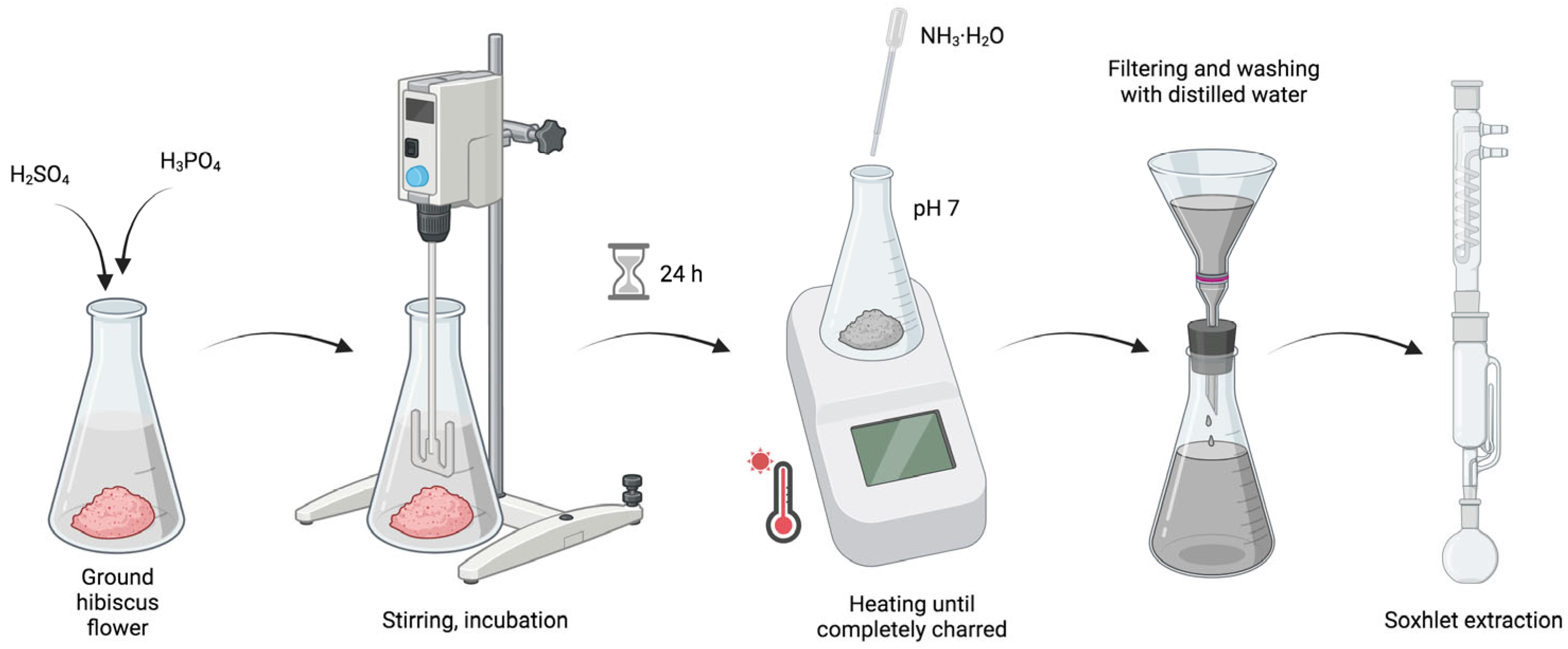
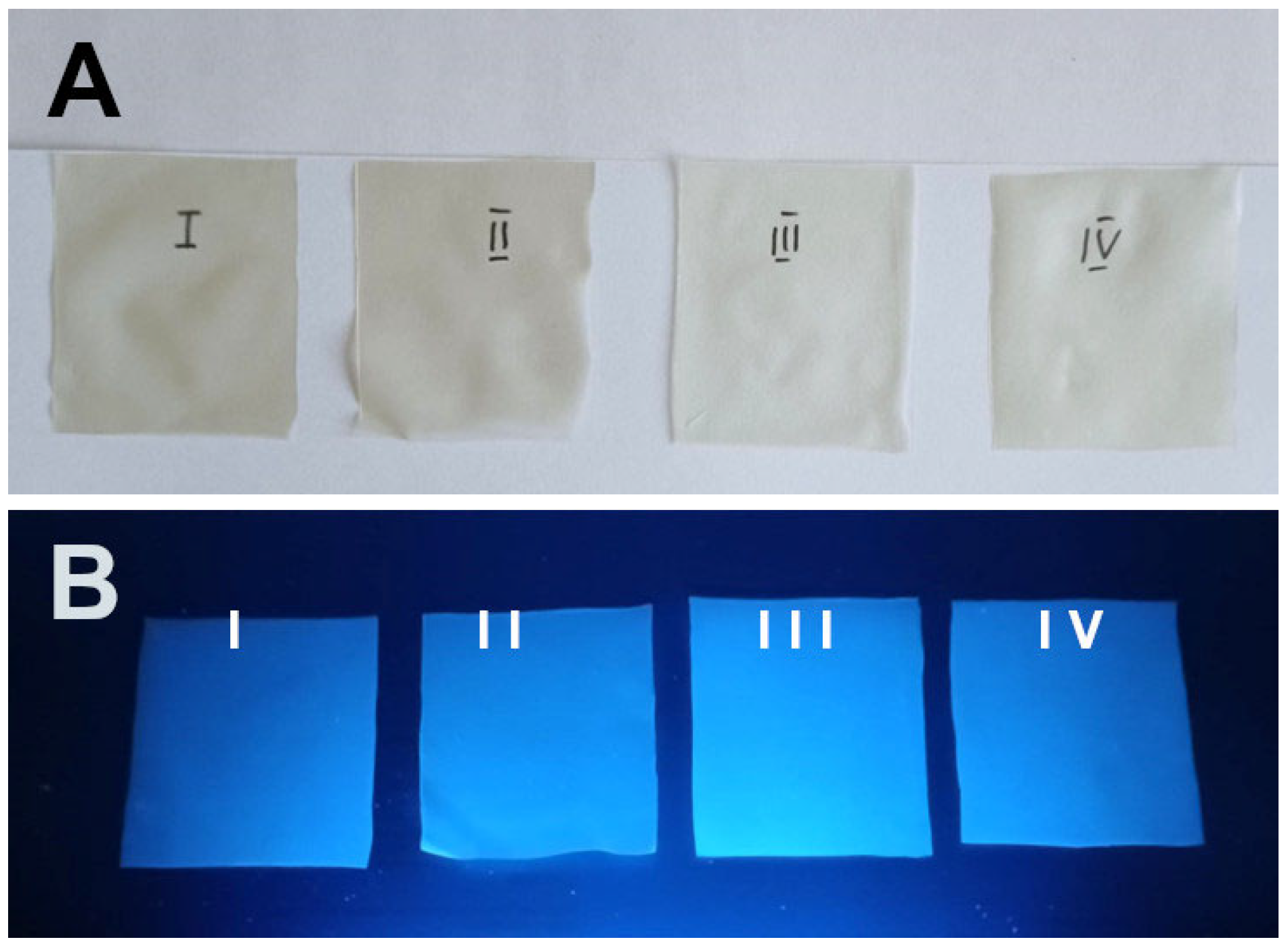
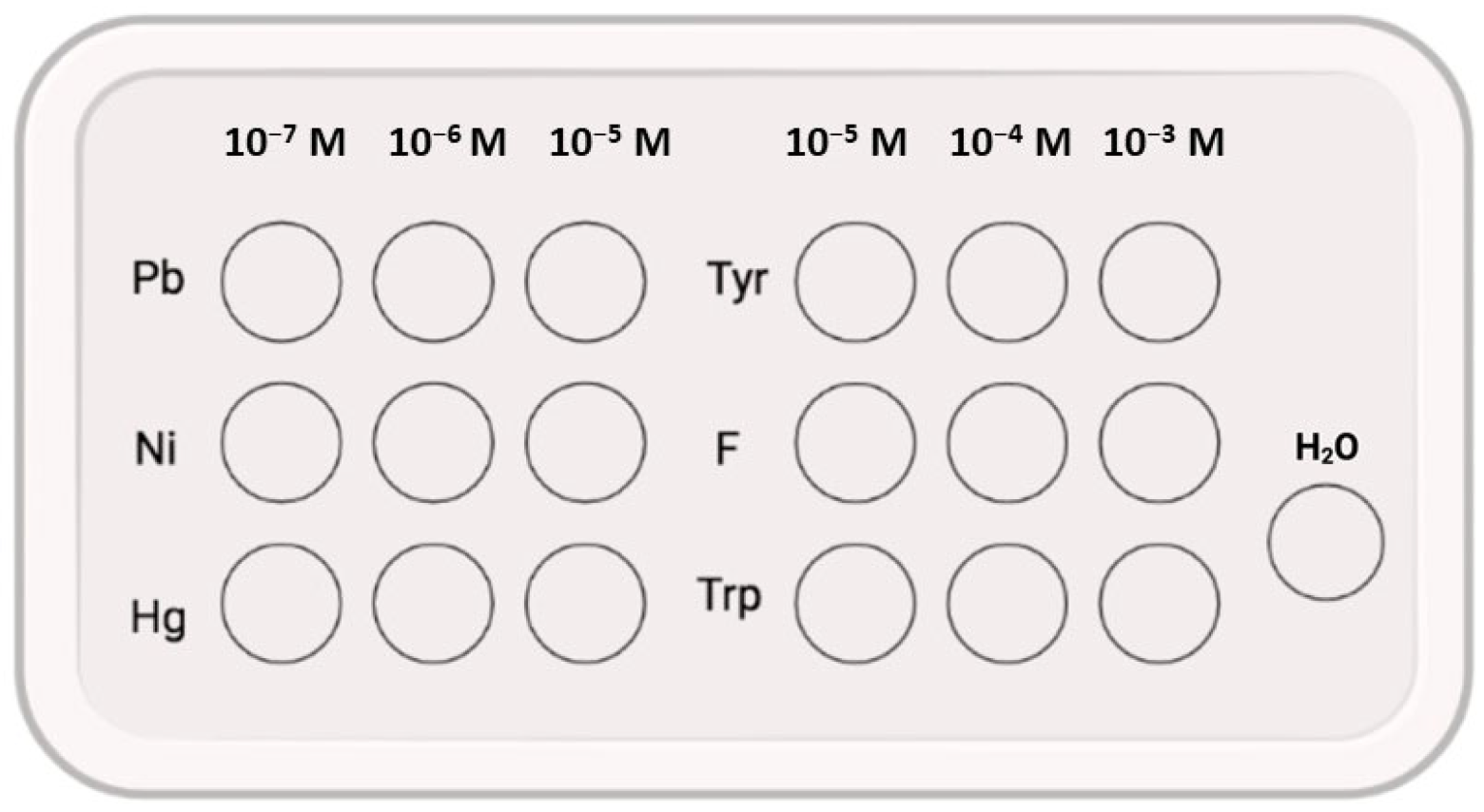
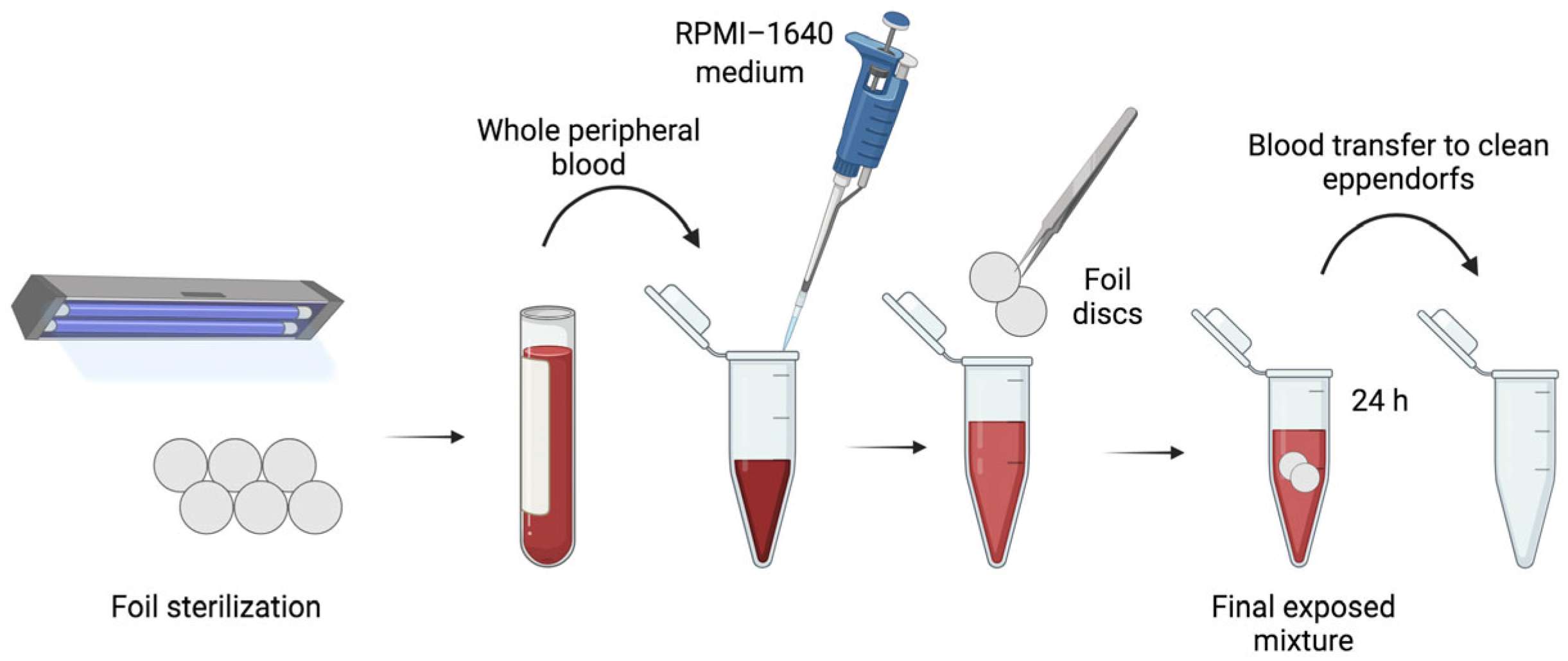

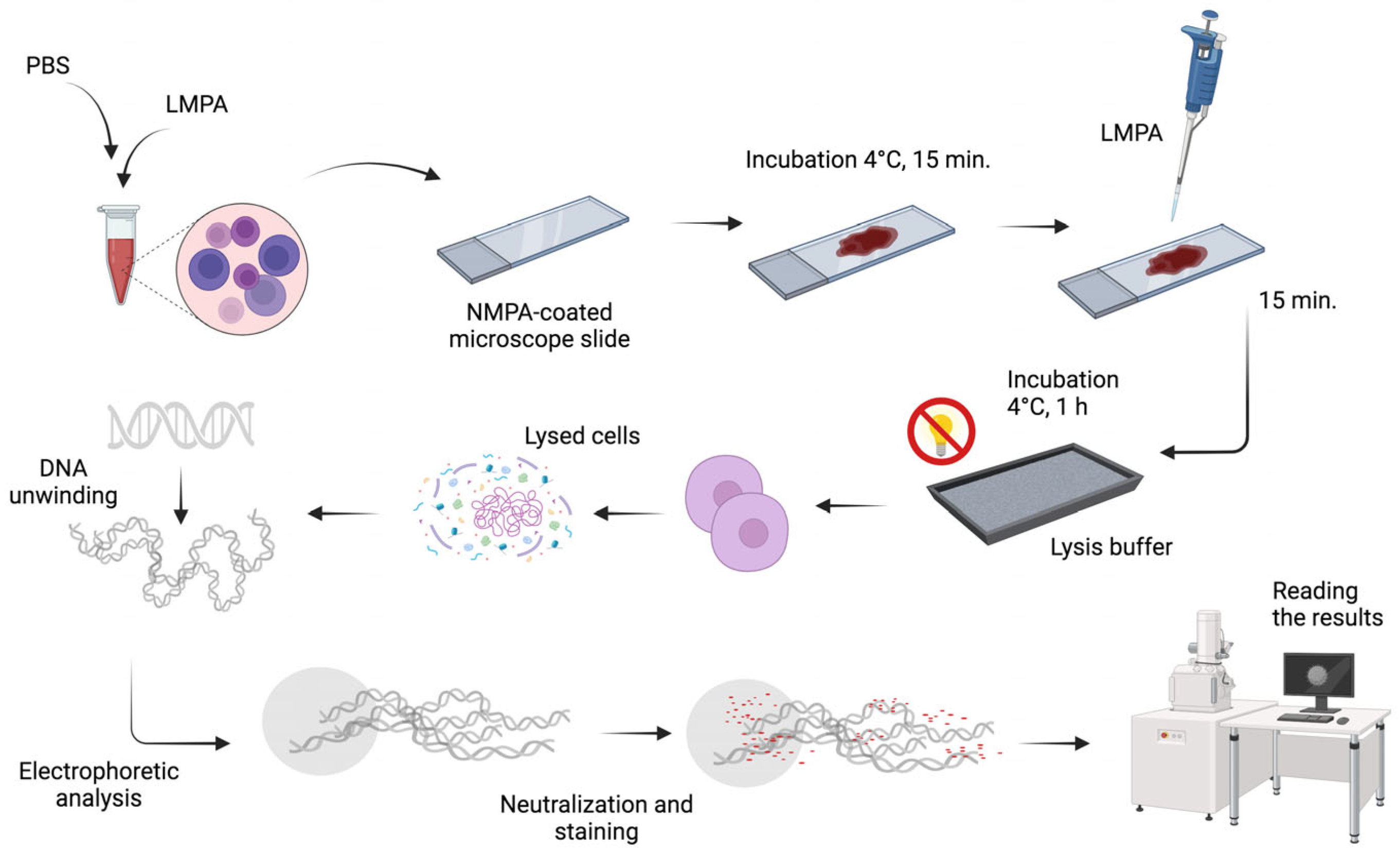


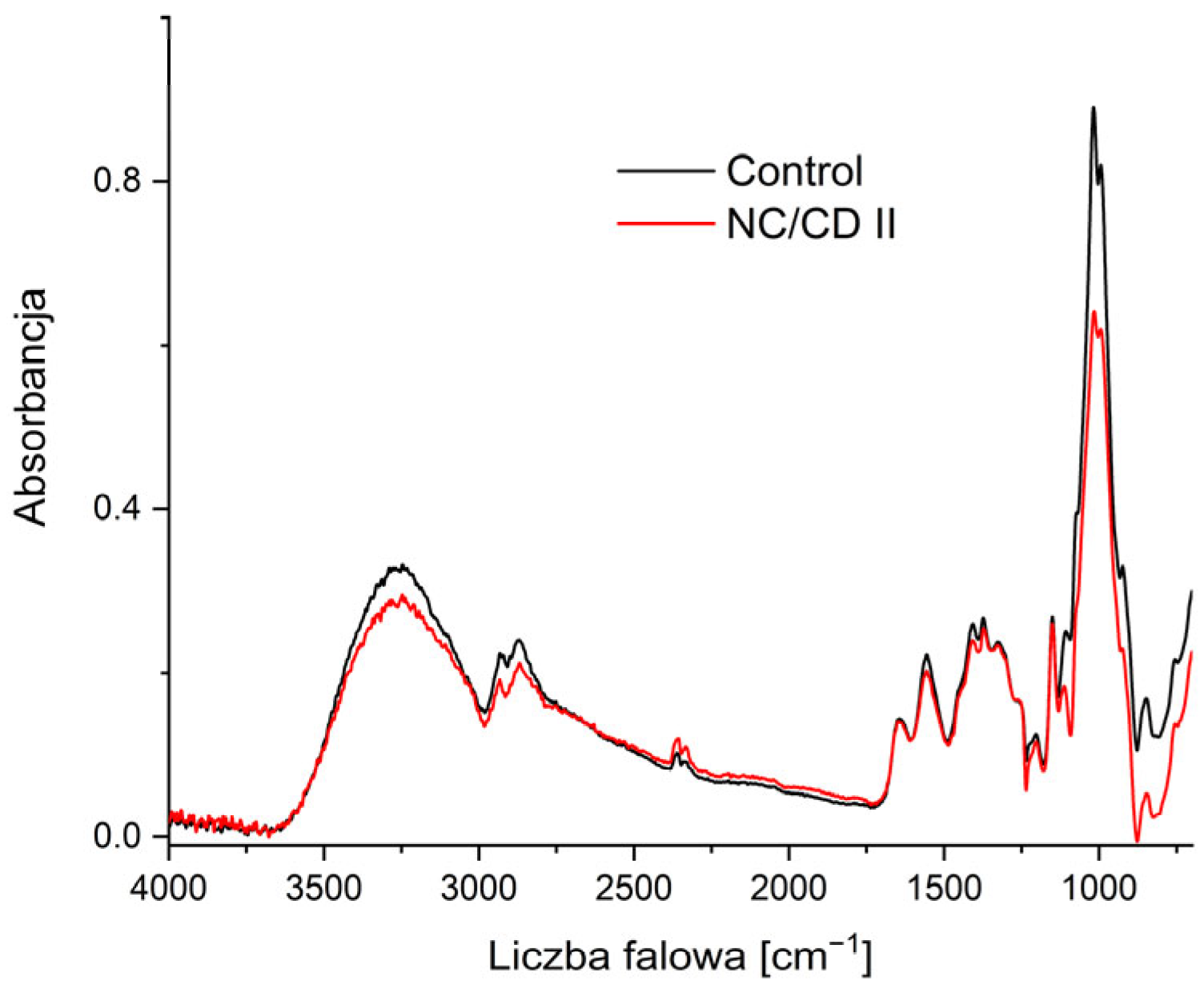
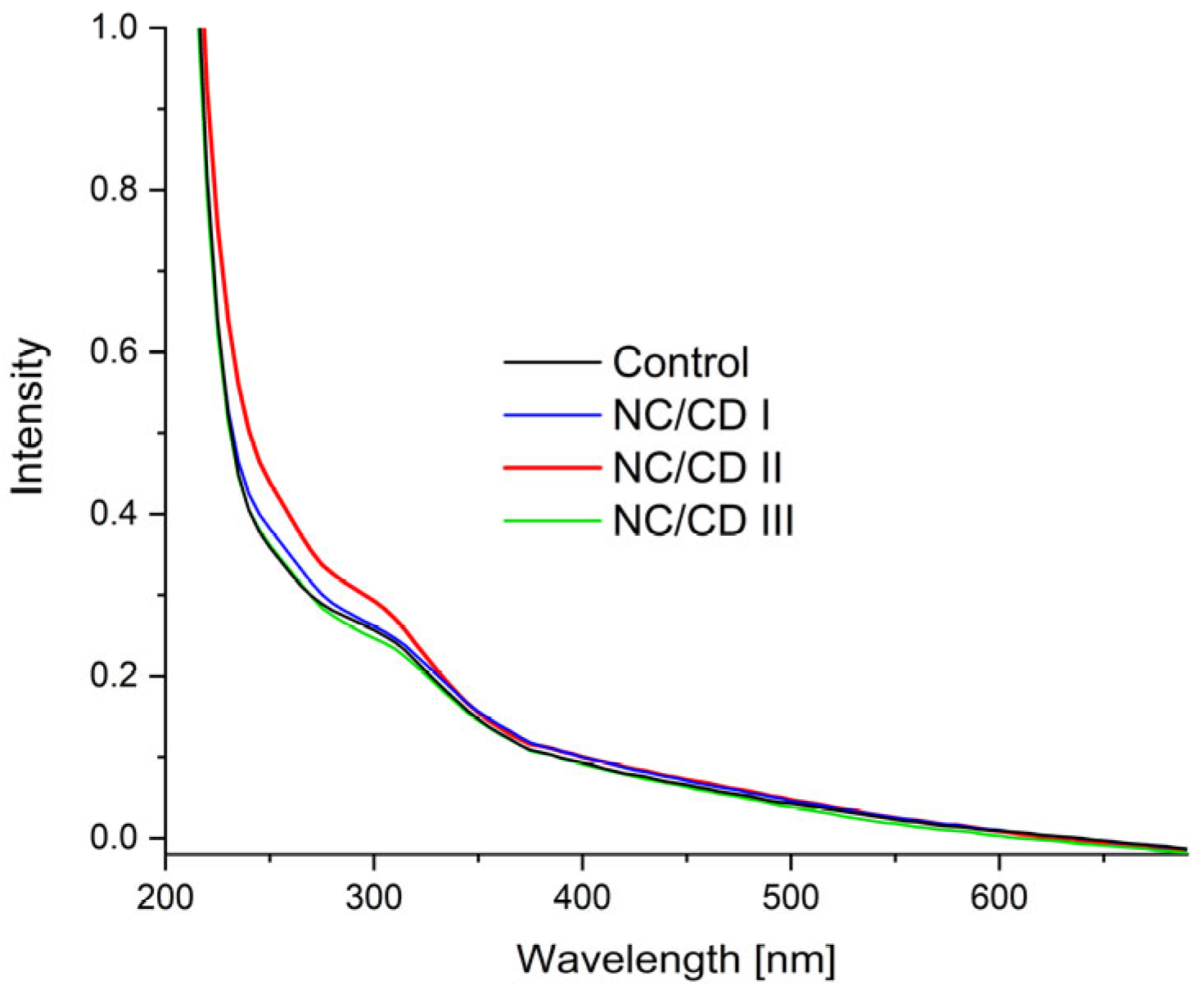
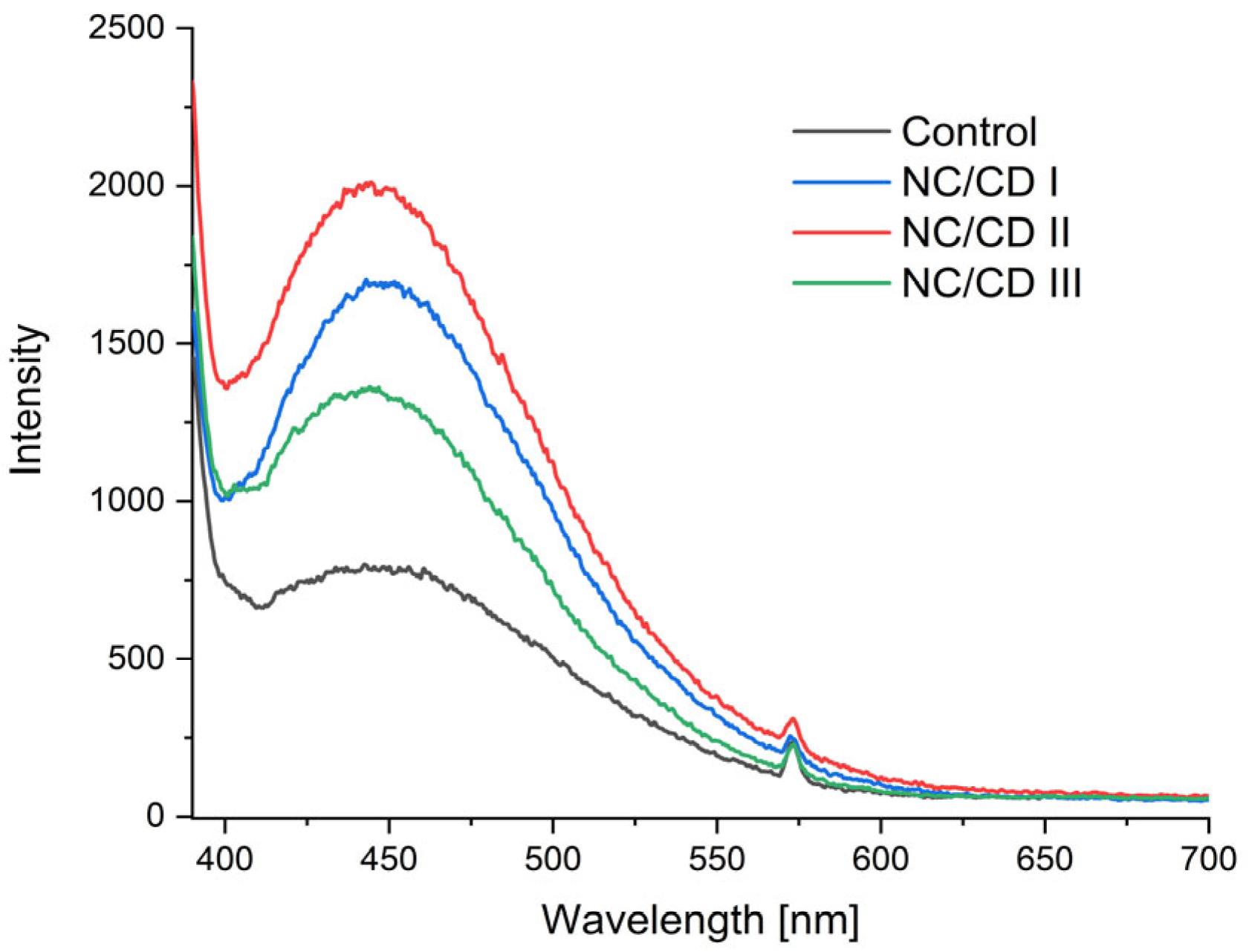
| Sample | L* (D65) | a* (D65) | b* (D65) | O (A × mm−1) |
|---|---|---|---|---|
| NC/CD I | 97.74 ± 0.1 C | −0.44 ± 0.04 C | 5.55 ± 0.31 A | 4.42 ± 0.24 C |
| NC/CD II | 97.94 ± 0.04 C | −0.41 ± 0.01 D | 5.68 ± 0.05 A | 4.45 ± 0.11 C |
| NC/CD III | 97.79 ± 0.06 B | −0.48 ± 0.02 B | 5.28 ± 0.16 B | 5.09 ± 0.27 B |
| Control | 98.13 ± 0.07 A | −0.59 ± 0.02 A | 5.17 ± 0.10 B | 5.86 ± 0.31 A |
| Sample | Water Content [%] | Solubility [%] | Swelling Degree [%] |
|---|---|---|---|
| NC/CD I | 12.25 ± 1.01 A | 33.64 ± 0.76 AB | 63.95 ± 0.62 A |
| NC/CD II | 10.43 ± 0.80 AB | 27.49 ± 1.02 C | 72.34 ± 1.16 C |
| NC/CD III | 10.45 ± 0.80 AB | 31.75 ± 0.46 A | 67.29 ± 0.49 B |
| Control | 8.80 ± 3.29 B | 33.79 ± 1.57 B | 65.49 ± 1.65 AB |
| Sample | Thickness (mm) | TS (MPa) | EAB (%) |
|---|---|---|---|
| NC/CD I | 0.138 ± 0.007 A | 2.42 ± 0.74 C | 45.86 ± 6.44 C |
| NC/CD II | 0.127 ± 0.007 B | 6.84 ± 1.17 A | 98.29 ± 6.05 A |
| NC/CD III | 0.136 ± 0.001 A | 3.37 ± 0.36 B | 80.19 ± 4.45 B |
| Control | 0.112 ± 0.006 C | 3.34 ± 0.54 B | 80.58 ± 5.04 B |
| Sample | Contact Angle | Surface Free Energy | |||
|---|---|---|---|---|---|
| Water [°] | Diiodomethane [°] | Polar [mJ/m2] | Dispersive [mJ/m2] | Total [mJ/m2] | |
| NC/CD I | 101.8 ± 3.6 | 52.8 ± 3.2 | 38.49 | 0.00 | 38.49 |
| NC/CD II | 97.2 ± 0.5 | 49.0 ± 4.4 | 40.02 | 0.10 | 40.13 |
| NC/CD III | 101.3 ± 5.0 | 52.4 ± 3.5 | 38.67 | 0.00 | 38.67 |
| Control | 95.4 ± 3.4 | 51.0 ± 1.9 | 37.97 | 0.35 | 38.32 |
| Sample | Pb2+ | Ni2+ | Hg2+ | Water | ||||||
|---|---|---|---|---|---|---|---|---|---|---|
| Concentration (M) | 10−7 | 10−6 | 10−5 | 10−7 | 10−6 | 10−5 | 10−7 | 10−6 | 10−5 | |
| Intensity | 1150 | 1491 | 2041 | 2030 | 1904 | 1377 | 2072 | 2132 | 3321 | 1836 |
| Sample | Tyr | Phe (F) | Trp | Water | ||||||
|---|---|---|---|---|---|---|---|---|---|---|
| Concentration (M) | 10−5 | 10−4 | 10−3 | 10−5 | 10−4 | 10−3 | 10−5 | 10−4 | 10−3 | |
| Intensity | 1150 | 1491 | 2041 | 2030 | 1904 | 1377 | 2072 | 2132 | 3321 | 1836 |
| Sample | Negative Control | NC/CD I | NC/CD II | NC/CD III | Control |
|---|---|---|---|---|---|
| Viability | 92.08 ± 1.08 A | 99.33 ± 0.17 BD | 99.50 ± 0.27 CD | 97.87 ± 0.54 ABC | 99.76 ± 0.13 D |
| Sample | Tail DNA | TM |
|---|---|---|
| NC/CD I | 12.33 ± 0.22 B | 7.91 ± 0.17 B |
| NC/CD II | 17.22 ± 0.30 A | 28.39 ± 0.71 A |
| NC/CD III | 25.56 ± 0.43 C | 35.65 ± 0.99 C |
| Control | 25.06 ± 0.35 D | 42.68 ± 0.99 D |
| Negative control | 16.41 ± 0.15 A | 24.23 ± 0.41 AC |
Disclaimer/Publisher’s Note: The statements, opinions and data contained in all publications are solely those of the individual author(s) and contributor(s) and not of MDPI and/or the editor(s). MDPI and/or the editor(s) disclaim responsibility for any injury to people or property resulting from any ideas, methods, instructions or products referred to in the content. |
© 2024 by the authors. Licensee MDPI, Basel, Switzerland. This article is an open access article distributed under the terms and conditions of the Creative Commons Attribution (CC BY) license (https://creativecommons.org/licenses/by/4.0/).
Share and Cite
Szczepankowska, J.; Woszczak, L.; Khachatryan, G.; Khachatryan, K.; Krystyjan, M.; Grzesiakowska-Dul, A.; Kuchta-Gładysz, M.; Wojciechowska-Puchałka, J.; Hovhannisyan, A.; Krzan, M. Preparation, Physicochemical, and Cyto- and Genotoxic Characterisation of Polysaccharide Composites Containing Carbon Quantum Dots. Materials 2024, 17, 2967. https://doi.org/10.3390/ma17122967
Szczepankowska J, Woszczak L, Khachatryan G, Khachatryan K, Krystyjan M, Grzesiakowska-Dul A, Kuchta-Gładysz M, Wojciechowska-Puchałka J, Hovhannisyan A, Krzan M. Preparation, Physicochemical, and Cyto- and Genotoxic Characterisation of Polysaccharide Composites Containing Carbon Quantum Dots. Materials. 2024; 17(12):2967. https://doi.org/10.3390/ma17122967
Chicago/Turabian StyleSzczepankowska, Joanna, Liliana Woszczak, Gohar Khachatryan, Karen Khachatryan, Magdalena Krystyjan, Anna Grzesiakowska-Dul, Marta Kuchta-Gładysz, Joanna Wojciechowska-Puchałka, Armen Hovhannisyan, and Marcel Krzan. 2024. "Preparation, Physicochemical, and Cyto- and Genotoxic Characterisation of Polysaccharide Composites Containing Carbon Quantum Dots" Materials 17, no. 12: 2967. https://doi.org/10.3390/ma17122967






